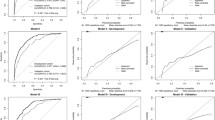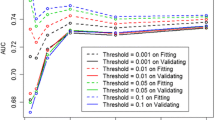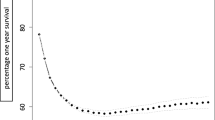Abstract
Despite overwhelming data on predictors of inpatient mortality, it is unclear which variables are the most instructive in predicting mortality of patients in departments of internal medicine. This study aims to identify the most informative predictors of inpatient mortality, and builds a prediction model on an individual level, given a constellation of patient characteristics. We use a penalized method for developing the prediction model by applying the least-absolute-shrinkage and selection-operator regression. We utilize a cohort of adult patients admitted to any of 5 departments of internal medicine during 3.5 years. We integrated data from electronic health records that included clinical, epidemiological, administrative, and laboratory variables. The prediction model was evaluated using the validation sample. Of 10,788 patients hospitalized during the study period, 874 (8.1%) died during admission. We find that the strongest predictors of inpatient mortality are prior admission within 3 months, malignant morbidity, serum creatinine levels, and hypoalbuminemia at hospital admission, and an admitting diagnosis of sepsis, pneumonia, malignant neoplastic disease, or cerebrovascular disease. The C-statistic of the risk prediction model is 89.4% (95% CI 88.4–90.4%). The predictive performance of this model is better than a multivariate stepwise logistic regression model. By utilizing the prediction model, the AUC for the independent (validation) data set is 85.7% (95% CI 84.1–87.3%). Using penalized regression, this prediction model identifies the most informative predictors of inpatient mortality. The model illustrates the potential value and feasibility of a tool that can aid physicians in decision-making.

Similar content being viewed by others
References
Steyerberg E (2009) Applications of prediction models. In: Steyerberg E (ed) Clinical prediction models: a practical approach to development, validation, and updating. Springer, New York, pp 11–31
Bo M, Raspo S, Massaia M, Cena P, Bosco F, Fabris F et al (2003) A predictive model of in-hospital mortality in elderly patients admitted to medical intensive care units. J Am Geriatr Soc 51:1507–1508
Nobre SR, Cabral JE, Gomes JJ, Leitao MC (2008) In-hospital mortality in spontaneous bacterial peritonitis: a new predictive model. Eur J Gastroenterol Hepatol 20:1176–1181
Tabak YP, Sun X, Nunez CM, Johannes RS (2013) Using electronic health record data to develop inpatient mortality predictive model: Acute Laboratory Risk of Mortality Score (ALaRMS). J Am Med Inf Assoc 21:455–463
Ouwerkerk W, Voors AA, Zwinderman AH (2014) Factors influencing the predictive power of models for predicting mortality and/or heart failure hospitalization in patients with heart failure. JACC Heart Fail 2:429–436
Smolin B, Levy Y, Sabbach-Cohen E, Levi L, Mashiach T (2014) Predicting mortality of elderly patients acutely admitted to the Department of Internal Medicine. Int J Clin Pract 69:501–508
Aylin P, Bottle A, Majeed A (2007) Use of administrative data or clinical databases as predictors of risk of death in hospital: comparison of models. BMJ. https://doi.org/10.1136/bmj.39168.496366.55
Walter S, Tiemeier H (2009) Variable selection: current practice in epidemiological studies. Eur J Epidemiol 24:733–736
Greenland S (2008) Variable selection versus shrinkage in the control of multiple confounders. Am J Epidemiol 167:523–529
Hernan MA, Hernandez-Diaz S, Werler MM, Mitchell AA (2002) Causal knowledge as a prerequisite for confounding evaluation: an application to birth defects epidemiology. Am J Epidemiol 155:176–184
Mickey RM, Greenland S (1989) The impact of confounder selection criteria on effect estimation. Am J Epidemiol 129:125–137
Austin PC, Tu JV (2004) Automated variable selection methods for logistic regression produced unstable models for predicting acute myocardial infarction mortality. J Clin Epidemiol 57:1138–1146
Arnold LD, Braganza M, Salih R, Colditz GA (2013) Statistical trends in the Journal of the American Medical Association and implications for training across the continuum of medical education. PLoS One 8:e77301. https://doi.org/10.1371/journal.pone.0077301
Narayanan R, Nugent R, Nugent K (2015) An investigation of the variety and complexity of statistical methods used in current internal medicine literature. South Med J 108:629–634
Tibshirani R (1997) The lasso method for variable selection in the Cox model. Stat Med 16:385–395
Sakhnini A, Saliba W, Schwartz N, Bisharat N (2017) The derivation and validation of a simple model for predicting in-hospital mortality of acutely admitted patients to internal medicine wards. Medicine (Baltimore) 96:e7284. https://doi.org/10.1097/MD.0000000000007284
Hastie T, Tibshirani R, Friedman J (2001) Model Assessment and Selection. In: Hastie T, Tibshirani R, Friedman J (eds) The elements of statistical learning, data mining, inference, and prediction, 2nd edn. Springer, New York, pp 193–224
Asadollahi K, Hastings IM, Gill GV, Beeching NJ (2011) Prediction of hospital mortality from admission laboratory data and patient age: a simple model. Emerg Med Australas 23:354–363
Froom P, Shimoni Z (2006) Prediction of hospital mortality rates by admission laboratory tests. Clin Chem 52:325–328
Jellinge ME, Henriksen DP, Hallas P, Brabrand M (2014) Hypoalbuminemia is a strong predictor of 30-day all-cause mortality in acutely admitted medical patients: a prospective, observational, cohort study. PLoS One 9:e105983. https://doi.org/10.1371/journal.pone.0105983
Silva TJ, Jerussalmy CS, Farfel JM, Curiati JA, Jacob-Filho W (2009) Predictors of in-hospital mortality among older patients. Clinics (Sao Paulo) 64:613–618
Asadollahi K, Beeching NJ, Gill GV (2010) Leukocytosis as a predictor for non-infective mortality and morbidity. QJM 103:285–292
Salciccioli JD, Marshall DC, Pimentel MA, Santos MD, Pollard T, Celi LA et al (2015) The association between the neutrophil-to-lymphocyte ratio and mortality in critical illness: an observational cohort study. Crit Care. https://doi.org/10.1186/s13054-014-0731-6
Baysal E, Cetin M, Yaylak B, Altntas B, Altndag R, Adyaman S et al (2015) Roles of the red cell distribution width and neutrophil/lymphocyte ratio in predicting thrombolysis failure in patients with an ST-segment elevation myocardial infarction. Blood Coagul Fibrinolysis 26:274–278
Jia M, Huang W, Li L, Xu Z, Wu L (2015) Statins Reduce mortality after non-severe but not after severe pneumonia: a systematic review and meta-analysis. J Pharm Pharm Sci 18:286–302
Jung JM, Choi JY, Kim HJ, Seo WK (2015) Statin use in spontaneous intracerebral hemorrhage: a systematic review and meta-analysis. Int J Stroke 10 Suppl(A100):10–17
Wang JQ, Wu GR, Wang Z, Dai XP, Li XR (2014) Long-term clinical outcomes of statin use for chronic heart failure: a meta-analysis of 15 prospective studies. Heart Lung Circ 23:105–113
Tabak YP, Sun X, Derby KG, Kurtz SG, Johannes RS (2010) Development and validation of a disease-specific risk adjustment system using automated clinical data. Health Serv Res 45:1815–1835
Nakas CT, Schutz N, Werners M, Leichtle AB (2016) Accuracy and calibration of computational approaches for inpatient mortality predictive modeling. PLoS One 11:e0159046. https://doi.org/10.1371/journal.pone.0159046
Tabak YP, Johannes RS, Silber JH (2007) Using automated clinical data for risk adjustment: development and validation of six disease-specific mortality predictive models for pay-for-performance. Med Care 45:789–805
Escobar GJ, Greene JD, Scheirer P, Gardner MN, Draper D, Kipnis P (2008) Risk-adjusting hospital inpatient mortality using automated inpatient, outpatient, and laboratory databases. Med Care 46:232–239
Kao SS, Kim SW, Horwood CM, Hakendorf P, Li JY, Thompson CH (2015) Variability in inpatient serum creatinine: its impact upon short- and long-term mortality. QJM 108:781–787
Zhao L, Wang L, Zhang Y (2009) Elevated admission serum creatinine predicts poor myocardial blood flow and one-year mortality in ST-segment elevation myocardial infarction patients undergoing primary percutaneous coronary intervention. J Invas Cardiol 21:493–498
Li ZY, Pu L, Chen ZH, An FH, Li LH, Li L et al (2014) Combined effects of admission serum creatinine concentration with age and gender on the prognostic significance of subjects with acute ST-elevation myocardial infarction in China. PLoS One 9:e108986. https://doi.org/10.1371/journal.pone.0108986
Yu MY, Lee SW, Baek SH, Na KY, Chae DW, Chin HJ et al (2017) Hypoalbuminemia at admission predicts the development of acute kidney injury in hospitalized patients: a retrospective cohort study. PLoS One 12:e0180750. https://doi.org/10.1371/journal.pone.0180750
Morotti A, Marini S, Lena UK, Crawford K, Schwab K, Kourkoulis C et al (2017) Significance of admission hypoalbuminemia in acute intracerebral hemorrhage. J Neurol 264:905–911
Huang YL, Hu ZD, Liu SJ, Sun Y, Qin Q, Qin BD et al (2014) Prognostic value of red blood cell distribution width for patients with heart failure: a systematic review and meta-analysis of cohort studies. PLoS One 9:e104861. https://doi.org/10.1371/journal.pone.0104861
Patel KV, Semba RD, Ferrucci L, Newman AB, Fried LP, Wallace RB et al (2009) Red cell distribution width and mortality in older adults: a meta-analysis. J Gerontol A Biol Sci Med Sci 65:258–265
Li YF, Luo J, Li Q, Jing YJ, Wang RY, Li RS (2012) A new simple model for prediction of hospital mortality in patients with intracerebral hemorrhage. CNS Neurosci Ther 18:482–486
Moons KG, Altman DG, Vergouwe Y, Royston P (2009) Prognosis and prognostic research: application and impact of prognostic models in clinical practice. BMJ 338:b606. https://doi.org/10.1136/bmj.b606
Pavlou M, Ambler G, Seaman SR, Guttmann O, Elliott P, King M et al (2015) How to develop a more accurate risk prediction model when there are few events. BMJ 351:h3868. https://doi.org/10.1136/bmj.h3868
Celi LA, Tang RJ, Villarroel MC, Davidzon GA, Lester WT, Chueh HC (2011) A clinical database-driven approach to decision support: predicting mortality among patients with acute kidney injury. J Healthc Eng 2:97–110
Celi LA, Galvin S, Davidzon G, Lee J, Scott D, Mark R (2013) A database-driven decision support system: customized mortality prediction. J Pers Med 2:138–148
Mayaud L, Lai PS, Clifford GD, Tarassenko L, Celi LA, Annane D (2013) Dynamic data during hypotensive episode improves mortality predictions among patients with sepsis and hypotension. Crit Care Med 41:954–962
Gaskin GL, Pershing S, Cole TS, Shah NH (2015) Predictive modeling of risk factors and complications of cataract surgery. Eur J Ophthalmol 26:328–337
Author information
Authors and Affiliations
Corresponding author
Ethics declarations
Conflict of interest
The authors declare that they have no conflict of interest.
Statement of human and animal rights
All procedures performed in the present study were in accordance with the ethical standards of the institutional and/or national research committee and with the 1964 Helsinki declaration and its later amendments or comparable ethical standards.
Informed consent
The present study retrospectively analyzed data abstracted from electronic health records thus informed consent was not required.
Rights and permissions
About this article
Cite this article
Schwartz, N., Sakhnini, A. & Bisharat, N. Predictive modeling of inpatient mortality in departments of internal medicine. Intern Emerg Med 13, 205–211 (2018). https://doi.org/10.1007/s11739-017-1784-8
Received:
Accepted:
Published:
Issue Date:
DOI: https://doi.org/10.1007/s11739-017-1784-8




